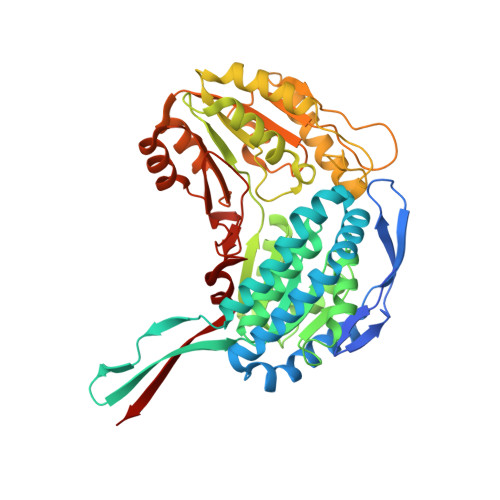Crystal Structure and Kinetics Identify Escherichia coli YdcW Gene Product as a Medium-chain Aldehyde Dehydrogenase
Gruez, A., Roig-Zamboni, V., Grisel, S., Salomoni, A., Valencia, C., Campanacci, V., Tegoni, M., Cambillau, C.(2004) J Mol Biology 343: 29-41
- PubMed: 15381418
- DOI: https://doi.org/10.1016/j.jmb.2004.08.030
- Primary Citation of Related Structures:
1WNB, 1WND - PubMed Abstract:
In the context of a medium-scaled structural genomics program aiming at solving the structures of as many as possible bacterial unknown open reading frame products from Escherichia coli (Y prefix), we have solved the structure of YdcW at 2.1A resolution, using molecular replacement. According to its sequence identity, YdcW has been classified into the betaine aldehyde dehydrogenases family (EC 1.2.1.8), catalysing the oxidation of betaine aldehyde into glycine betaine. The structure of YdcW resembles that of other aldehyde dehydrogenases: it is tetrameric and binds a NADH molecule in each monomer. The NADH molecules, bound in the active site by soaking, are revealed to be in the "hydrolysis position". Activities experiments demonstrate that YdcW is more active on medium-chains aldehyde than on betaine aldehyde. However, soaking of betaine into YdcW crystals revealed its presence in one of the subunits, in two positions, a putative resting position and a hydride transfer ready position. Analysis of kinetics data and of the active site shape suggest an optimum binding of n-alkyl aldehydes up to seven to eight carbon atoms, possibly followed by a bulky cyclic or aromatic group.
- Architecture et Fonction des Macromolécules Biologiques, UMR 6098 CNRS, 31 chemin J. Aiguier, F-13402 Marseille Cedex 20, France.
Organizational Affiliation:


















